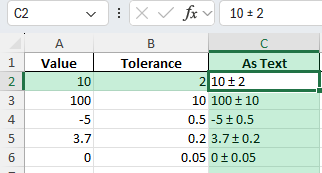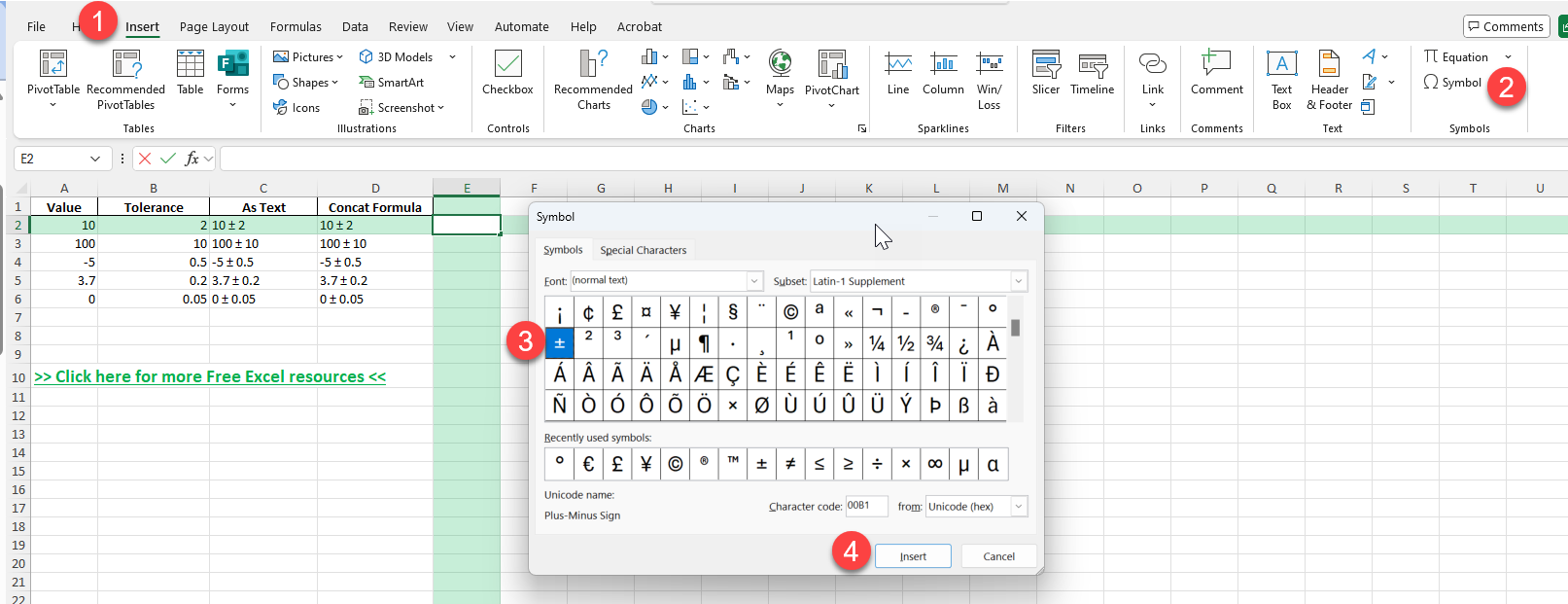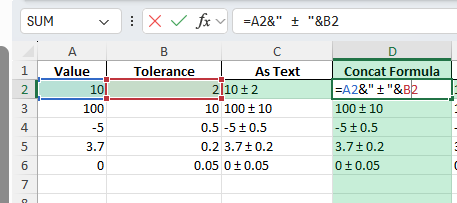Key Takeaways
- You can insert the plus minus symbol (±) using Alt codes or Excel’s Symbol dialog.
- The Alt code for ± is Alt + 0177 (use the numeric keypad).
- Plus minus can also be added through formulas, custom formatting, or VBA.
- Consistent use of ± improves clarity in engineering, science, and finance documents.
- Automating ± with helper columns or macros speeds up frequent use in large datasets.
Table of Contents
How to Insert the Plus Minus Symbol in Excel
Step 1: Insert Using the Alt Code
Click the cell where you want to add the symbol.
Press and hold the Alt key.
Type 0177 on your numeric keypad (not the row of numbers above your letters).
Release the Alt key. The ± symbol will appear.
Note: On a laptop, you may need to use Fn + NumLock to enable the numeric keypad, or use the Symbol dialog method.
Step 2: Insert Using the Symbol Dialog
Select the cell where you want to insert the symbol.
Go to Insert > Symbol in the Excel ribbon.
In the Symbol window, set “Font” to (normal text).
Scroll to find the ± symbol, or enter Character code 00B1.
Click Insert, then Close.
Step 3: Insert Plus Minus in a Formula or Concatenate with Text
To add ± between two values, use:
=A2 & " ± " & B2
This displays “value ± value” directly in your worksheet.
Common Mistakes and Tips
Mistake: Using the wrong Alt code
Always use Alt + 0177 (with leading zero). Typing Alt + 177 may not work in all versions or keyboards.
Mistake: Using the number row instead of the numeric keypad
Alt codes require the numeric keypad on your keyboard.
Tip: Copy and paste the ± symbol if shortcuts do not work
Just copy ± from this article and paste it in your Excel cell.
Tip: Add ± to AutoCorrect for faster insertion
Go to File > Options > Proofing > AutoCorrect Options and set a shortcut like “pm” to automatically replace with ±.
Tip: Use CHAR(177) in formulas
=A2 & " " & CHAR(177) & " " & B2
Bonus Tips and Advanced Scenarios
VBA: Insert ± Programmatically
Use this VBA macro to quickly insert ± in the selected cell:
Sub InsertPlusMinus() ActiveCell.Value = ActiveCell.Value & " ± " End Sub
You can assign this macro to a button for even faster use.
Power Query: Add ± to Transformed Data
In Power Query, create a custom column:
Text.From([Value]) & " ± " & Text.From([Tolerance])
Conditional Formatting: Highlight Tolerance Values
Use conditional formatting to automatically highlight rows where a ± is present.
Leveraging the Plus/Minus Symbol Across Platforms
Inserting on MacOS
Inserting the plus/minus symbol on MacOS is streamlined for efficiency, perfect for users frequently transitioning between tasks. Mac users can quickly input symbols using built-in shortcuts and character viewers, maximizing productivity.
Here’s how to insert the plus/minus symbol on MacOS:
- Keyboard Shortcut: Press Option + Shift + = (equals) to instantly generate the ± symbol in any application or text field.
- Character Viewer: Go to the menu bar and select Edit > Emoji & Symbols. In the search bar, type “plus minus” to find and insert the symbol directly.
These methods provide flexibility and are essential for users who frequently employ mathematical expressions or statistical data presentations. If you’re an analyst or academic professional, this functionality ensures seamless integration of symbols into your documents.
Adding to Android and iOS Devices
Adding the plus/minus symbol to documents on Android and iOS devices involves utilizing the device’s built-in keyboard features, ensuring accessibility and efficiency when working on-the-go.
For Android Devices:
- Use the Gboard (Google Keyboard): Press the “=?123” key to switch to numeric and symbol layout.
- Tap the “*= (equals)” symbol, then hold it down until additional options appear.
- Slide to select the plus/minus symbol (±).
For iOS Devices:
- Open the keyboard and tap the “123” key to access the number and symbol layout.
- Press and hold the “-” key to reveal the plus/minus symbol in the pop-up menu.
- Slide your finger to select the ± symbol.
These steps are designed for users who frequently work with spreadsheets or documents on mobile platforms, ensuring that data presented remains consistent regardless of the platform used. This ability to insert symbols easily empowers them to maintain professional-grade documentation away from the desktop.
Practical Applications and Examples
Integrating Plus/Minus in Financial Models
Integrating the plus/minus symbol in financial models enhances clarity in representing variables with potential variance, such as forecasts and budgets. This symbol, often used in investment analysis, indicates a range of possible outcomes, allowing you to communicate uncertainty elegantly without overwhelming details. In Excel, a well-placed plus/minus can differentiate between static and variable assumptions, enriching the model’s interpretive depth.
Consider a case study: a company projects revenue growth between 5% and 7%. By using the plus/minus symbol, this range appears more professionally, aiding in swift interpretation.
Enhancing Data Visualization Techniques
Incorporating the plus/minus symbol in data visualizations refines your ability to present statistical data and forecast ranges effectively. It creates a visual shorthand for representing variability or uncertainty in data sets, such as margin of error or confidence intervals. In Excel charts, using this symbol simplifies understanding of complex graphs, enhancing readability and quickly conveying important insights.
For example, when plotting quarterly performance metrics, including plus/minus symbols to indicate possible variance helps audiences grasp the full scope of data trends at a glance without sifting through explanations. An effective chart might show sales performance with error bars, directly reflecting potential fluctuations using the symbol for clarity.
FAQ
Q: What is the Alt code for the plus minus symbol?
A: Alt + 0177 on the numeric keypad.
Q: Why doesn’t the Alt code work on my laptop?
A: Some laptops do not have a numeric keypad. Use the Symbol dialog or copy and paste the symbol.
Q: Can I use the plus minus symbol in Excel formulas?
A: Yes. Use CHAR(177) or concatenate the ± symbol directly into your formula.
Q: How can I add ± to many cells at once?
A: Use AutoCorrect, fill down a helper formula, or run a VBA macro for batch updates.
Q: Is the plus minus symbol available in all fonts?
A: The symbol ± is available in most standard fonts, but it is safest to use (normal text) in the Symbol dialog.
John Michaloudis is a former accountant and finance analyst at General Electric, a Microsoft MVP since 2020, an Amazon #1 bestselling author of 4 Microsoft Excel books and teacher of Microsoft Excel & Office over at his flagship MyExcelOnline Academy Online Course.










